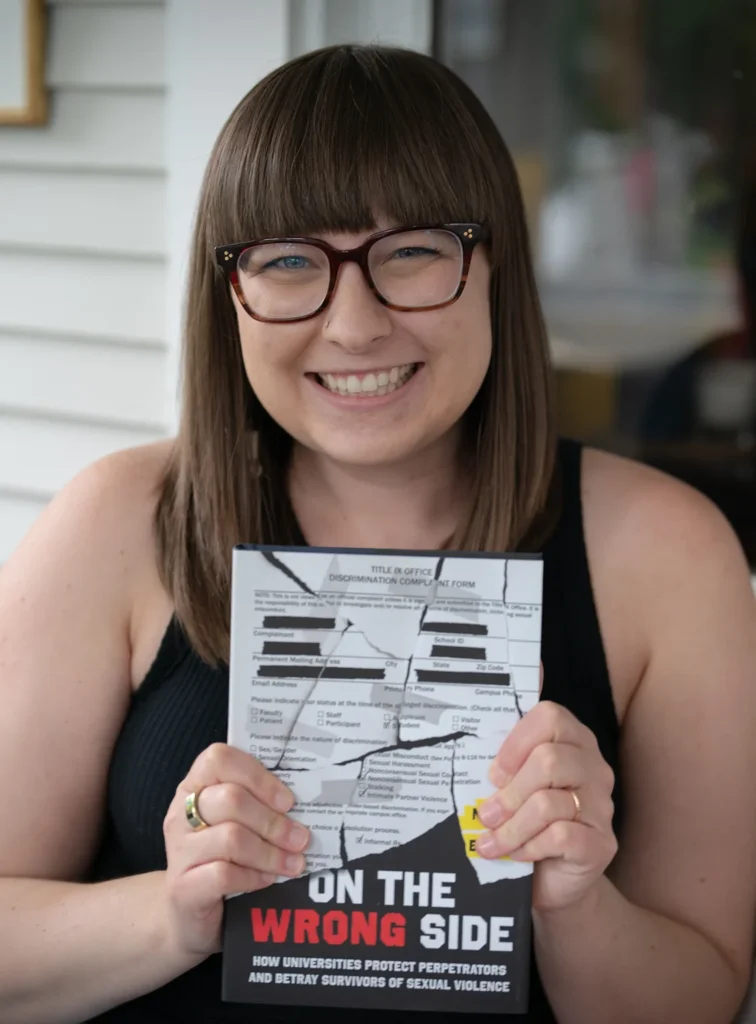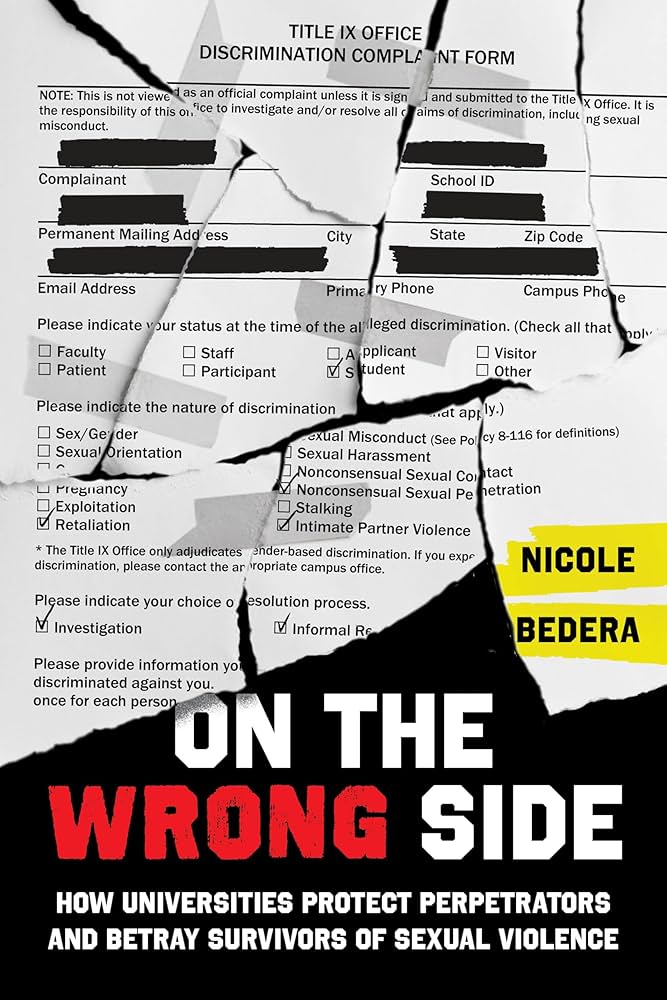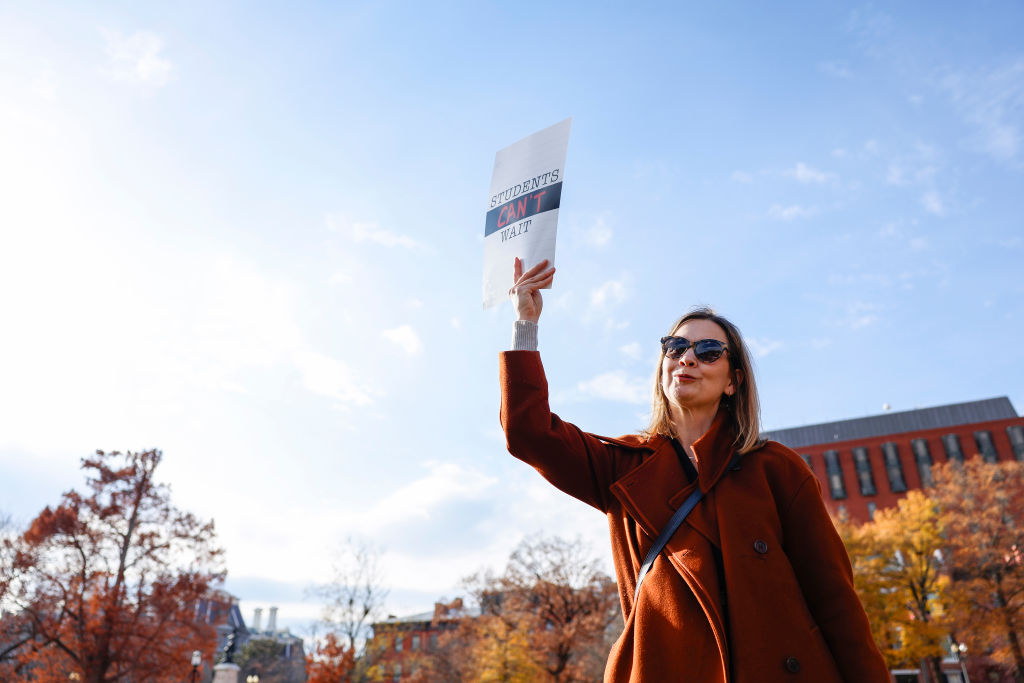
When sociologist Nicole Bedera set out to study sexual assault on college campuses, she knew that Title IX of the Education Amendments of 1972 was meant to protect victims of intimate-partner violence—a largely female-identified group of students who experience gender-based discrimination, rape, sexual harassment and stalking—at every college or university that receives federal money.
Her first book, On the Wrong Side: How Universities Protect Perpetrators and Betray Survivors of Sexual Violence, looks into how Title IX has fared in the 52 years since its passage.
The short answer? Badly.
“Without a clear enforcement mechanism,” she writes, “very little has changed.”

Finding out why, and determining whether this is intentional or is a procedural flaw, led Bedera to spend the 2018-2019 academic year at the pseudonymously-named Western University—the location and identity of the large, public institution is protected throughout the book—where she interviewed 69 people, including 45 students (victims and perpetrators) and 24 administrators. She also read more than 700 web pages, emails, news articles and other documents pertinent to the school’s approach to sexual assault.
Her findings are appalling. “Just as Western University has prioritized paying the football coach over victim advocates, the Title IX process prioritized accused male students’ educations over their victims. The structures governing the Title IX system were so unfair to survivors that no amount of hard work could overcome them, especially since the staff most sympathetic to victims were almost always the ones with the least power. I observed systems designed to benefit (white, straight, cisgender) men, even when they were the ones in the wrong.”
Bedera spoke to Ms. reporter Eleanor J. Bader about her research in early October to coincide with the book’s release by the University of California Press.
Eleanor J. Bader: Let’s start with the men accused of sexual assault or harassment. On the Wrong Side details how Western University, and likely other colleges and universities throughout the U.S., bend over backward to ensure that male lives are not “ruined.” What’s this about?
Nicole Bedera: It’s helpful to start with a little data. Studies find that the average college expels just one perpetrator of sexual assault every three years. In general, schools tend to prefer more lenient sanctions like attending a training or writing an essay. Most of the time, they refuse to intervene at all.
This approach to discipline assumes a perpetrator made a mistake or didn’t understand the impact of their actions. When I interviewed perpetrators, I always asked them how they reacted to the first email they received from Title IX, if they understood what they were accused of and if they knew what the complaint against them was about. All said “yes.”
It reminded me of some of my earlier work on men’s experiences seeking consent in their sexual encounters. There was a phrase that kept coming up. Participants would say, “It wasn’t rape, it was just nonconsensual sex.” In both studies, I found that the men who commit these acts of violence think they’re entitled to it even if they knowingly hurt their partners. They believe that sex is their right.
We don’t need to sit perpetrators down and explain sexual consent. They know what consent means. Instead, what we need to do is create policies that end their ability to benefit from sexual assault. There needs to be consequences for what they’ve done, including expulsion or suspension.
I do not say this from a framework of punishing the perpetrator. The distinction between consequences and punishment is important. There has been a real rush to shield perpetrators from any consequences for what they’ve done.
Sexual violence always produces negative consequences. These consequences are unavoidable, and by sparing perpetrators, college policies burden victims. Administrators seem to live in a fantasy world where there can be a sexual assault without consequences. They believe that slow or no action will make the problem disappear and that survivors need to get on with their lives. For many survivors, this is not possible, and they end up being the ones to drop out or transfer. Meanwhile, their perpetrators are still on campus.
We don’t have the tools to change the hearts and minds of perpetrators, which is why this problem seems so impossible to solve. However, if perpetrators are removed from campus, the victims can stay in school and complete their degrees.
I also believe that removing perpetrators will reduce or eliminate their power. It will create a more equal campus where the power disparities that perpetrators need won’t exist in the same way.
In the book, I quote numerous national studies showing that the process harmed nearly all of the women who tried to follow their school’s Title IX protocols. Their traumatic symptoms deepened, mental and physical health deteriorated, support systems faltered and threats to their safety intensified. And their schoolwork suffered, even though Title IX was designed to protect their academic progress. Instead, the process prioritizes the perpetrators at the expense of the victims. It’s very backwards.
The average college expels just one perpetrator of sexual assault every three years.
Nicole Bedera

Bader: How did the Title IX process at Western University protect perpetrators?
Bedera: The school worked extremely hard to ensure that all processes were “fair” to the accused. In the name of “due process,” they created a series of obstacles that would be difficult for survivors to complete. Most of the time, the school made complaints disappear before the perpetrator was even alerted about it.
For example, Western University offered survivors “choices” that they struggled to understand or were never even told about. There was a difference between a report and a complaint, between informal and formal reporting options. And the distinctions weren’t clear.
Survivors would enter into a process without knowing what decision they’d made and often would enter a dead end without realizing it. They did everything they were asked to do and never heard back from anyone, which showed them that the university didn’t care about them. They had agonized over whether to report, and the process was impossible to complete. Most of the time, survivors blamed themselves, but all their cases derailed in predictable ways with devastating impacts.
If a case did make it past all of the early barriers, survivors encountered new problems. Faculty and Title IX office staff often think of themselves as experts on sexual violence, but many have a dated and offensive understanding of it. One of the administrators in the study told me that he hesitated to consider something as rape unless it involved “a stranger jumping out of the bushes.” Survivors’ experiences were consistently misunderstood and minimized.
This was especially clear in the context of no-contact directives.
At Western, no-contact directives are similar to protective orders in the criminal justice system, but the involved parties are forbidden from talking about each other. The school casts these agreements as neutral, but telling both parties that they can’t speak about what happened uniquely damages victims. The intended function may be to keep the perpetrator from smearing the reputation of the survivor. But it also keeps victims from telling others about what happened to them or even warning other women about their experiences with a particular man. This restriction shocks survivors, who usually don’t know they’ll be constrained until after they sign the form. It’s a bait-and-switch.
Bader: On the Wrong Side highlights a case in which the perpetrator, a well-regarded athlete, was assisted in transferring to another school with a scholarship but did so without any mention of his expulsion for sexual misconduct.
Bedera: It’s rare for perpetrators to face any sanction, but that case was pretty typical of what it looks like when they do. It took a confession to convince school administrators to act, but then they felt as if they needed to set the perpetrator up to succeed elsewhere. The comment “their lives will be ruined” was constantly said among staff, as if a lifetime of destitution awaits anyone who is held accountable.
In another case, a perpetrator voluntarily withdrew from the school during the investigation but was able to retain his on-campus job at the college where the sexual assault took place. The victim worked in the same building as him. The school considered that case a success, but the survivor still had to see her perpetrator on campus.
One of the administrators … told me that he hesitated to consider something as rape unless it involved ‘a stranger jumping out of the bushes.’ Survivors’ experiences were consistently misunderstood and minimized.
Bedera
Bader: What is the relationship between campus and city police?
Bedera: The line between the two is often blurry. It’s worth nothing that many victims don’t want to involve the police. They go to Title IX because their sexual assaults are impacting their education, and no police department can offer them educational remedies. Only their school can do that.
Western University is a public university, and most public universities in the U.S. have their own police departments. Even if a survivor goes to the police, the police are often an extension of their school. And the relationship between campus and city police can be difficult. There are a lot of arguments over jurisdiction.
For example, a survivor who was sexually assaulted in the dorms will be told to report to campus police since the dorms are on campus. However, if the perpetrator lives off campus, the university police might refuse to leave their jurisdiction to interview him.
The jurisdiction issues are most visible on the edge of campus, including fraternity row. When a white fraternity is involved, both city and school police will point at each other and claim the fraternity is in the other’s jurisdiction. But when a Black fraternity is involved, it becomes a matter of dual jurisdiction. Both precincts are eager to step in.
Bader: Did you see differences in how survivors of color or perpetrators of color were treated compared to white people? How about when the victims were queer?
Bedera: The most obvious difference is that the Title IX system wasn’t designed to capture survivors’ intersectional experiences. Title VII of the Civil Rights Act of 1964 prohibits racial discrimination in employment and on campus—but when a woman of color reported sexual harassment that included some form of racial harassment, she was advised to file both a Title VII and a Title IX complaint. One process couldn’t capture both dimensions of her experience. She was chastised for the overlap between the two cases as if she was trying to punish her perpetrator twice. The two complaints would cancel each other out, and a victim wouldn’t get an intervention through either one.
When harassment was both racist and sexist, administrators treated it as if it were neither.
Queer sexual victimization looks a little different than people expect. A lot of my previous work is on queer women’s experiences of sexual assault, and the perpetrators are still overwhelmingly straight cisgender men. In this study, I found that queer survivors were usually perceived as straight by school administrators because they did not disclose their gender. Their identities were erased, and that meant school administrators misunderstood crucial components of their experiences.
They go to Title IX because their sexual assaults are impacting their education, and no police department can offer them educational remedies. Only their school can do that.
Bedera
Bader: In addition to consequences for perpetrators, what other changes do you suggest?
Bedera: There are a lot of well-intended interventions for survivors that just aren’t working.
One of the overarching themes is that survivors who needed academic accommodations were told to drop the classes that were causing them trouble. It wasn’t a viable option for students reliant on financial aid, since they must attend school full-time to continue receiving assistance. Dropping one class sometimes requires dropping out altogether.
Once students failed a class—whether they were survivors or perpetrators—they were able to withdraw from classes retroactively and get their tuition for those classes refunded. That can be helpful in the short-term, but they weren’t making degree progress. Since a lot of scholarships expire after four or five years, students can run out of funding and struggle to afford school as they try to finish their degrees.
In general, though, I question whether or not we should focus on approaches that expect survivors to sacrifice educational opportunities.
It’s worth pointing out that survivors didn’t struggle in all of their classes. They typically did well and finished classes where the professor was flexible and trauma-informed. They had difficulties in classes where the instructor was harsh, rigid or made sexist comments.
Colleges should strive to make every class trauma-informed so that survivors can thrive in school. We can do this, and we’ve done it before: Professors were creative about teaching students traumatized by the COVID-19 pandemic. If we use the tools we already have, we can benefit students facing crises of all kinds.
A lot of well-meaning professors reach out to me and tell me that they want to be proactive in case they have a survivor in their classes. In reality, every professor has survivors in every class. They probably have perpetrators in most, if not all, of their classes, too. Educators need to recognize how prevalent and predictable sexual violence is and stop denying that it is a problem in their schools or their classrooms. They need to design their courses knowing that survivors are not anomalies.
Bader: You wrote, “Institutional betrayal was a feature of the school’s Title IX system, rather than an occasional regrettable mistake.” The Biden administration has just issued updated Title IX regulations that took effect on Aug. 1. Will this help?
Bedera: The Biden regulation is not the sweeping Title IX reform we need. The new regulations give schools more power to choose how they want to handle Title IX, especially on contentious issues like whether to have live hearings with cross-examination and which standards of evidence to use.
Schools seem to be moving in partisan directions based on state laws or state culture, similar to how individual states are handling abortion access. There is a good chance that where a student chooses to go to school will determine the type of Title IX changes they can expect in the next few years. We need to push our schools in the direction we want them to take.
At Ms. magazine, our mission is to deliver facts about the feminist movement (and those who stand in its way) and foster informed discussions—not to tell you who to vote for or what to think. We believe in empowering our readers to form their own opinions based on reliable reporting. To continue providing you with independent feminist journalism, we rely on the generous support of our readers. Please consider making a tax-deductible donation today if you value the work we do and want to see it continue. Thank you for supporting women’s voices and rights.





